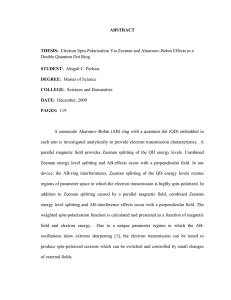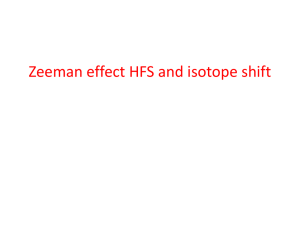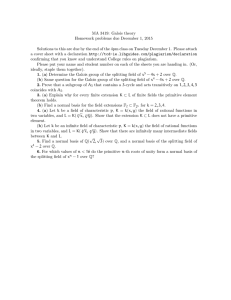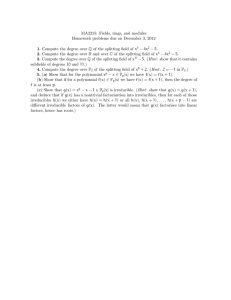The Zeeman Effect MORE CHAPTER 7, #2
advertisement
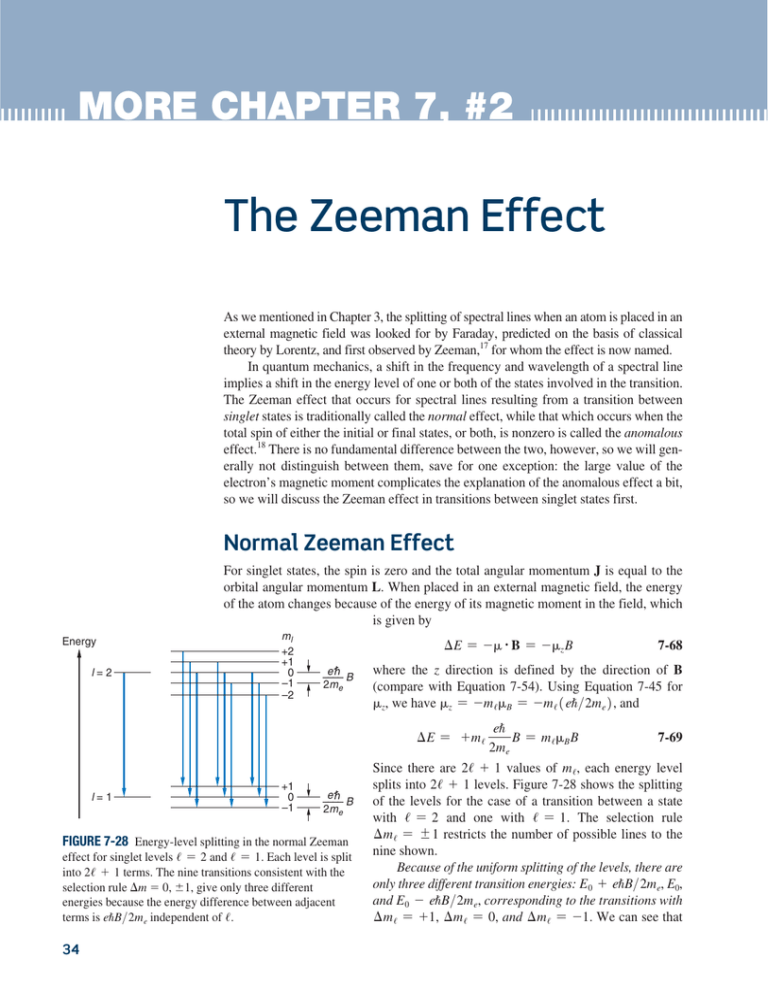
MORE CHAPTER 7, #2
The Zeeman Effect
As we mentioned in Chapter 3, the splitting of spectral lines when an atom is placed in an
external magnetic field was looked for by Faraday, predicted on the basis of classical
theory by Lorentz, and first observed by Zeeman,17 for whom the effect is now named.
In quantum mechanics, a shift in the frequency and wavelength of a spectral line
implies a shift in the energy level of one or both of the states involved in the transition.
The Zeeman effect that occurs for spectral lines resulting from a transition between
singlet states is traditionally called the normal effect, while that which occurs when the
total spin of either the initial or final states, or both, is nonzero is called the anomalous
effect.18 There is no fundamental difference between the two, however, so we will generally not distinguish between them, save for one exception: the large value of the
electron’s magnetic moment complicates the explanation of the anomalous effect a bit,
so we will discuss the Zeeman effect in transitions between singlet states first.
Normal Zeeman Effect
For singlet states, the spin is zero and the total angular momentum J is equal to the
orbital angular momentum L. When placed in an external magnetic field, the energy
of the atom changes because of the energy of its magnetic moment in the field, which
is given by
Energy
l=2
ml
+2
+1
0
–1
–2
E = - # B = -z B
e
–––– B
2me
where the z direction is defined by the direction of B
(compare with Equation 7-54). Using Equation 7-45 for
z, we have z = -m /B = -m / 1eU>2m e 2, and
eU
B = m /B B
7-69
2m e
Since there are 2/ + 1 values of m /, each energy level
splits into 2/ + 1 levels. Figure 7-28 shows the splitting
of the levels for the case of a transition between a state
with / = 2 and one with / = 1. The selection rule
m / = {1 restricts the number of possible lines to the
nine shown.
Because of the uniform splitting of the levels, there are
only three different transition energies: E 0 + eUB>2m e, E0,
and E 0 - eUB>2m e, corresponding to the transitions with
m / = +1, m / = 0, and m / = -1. We can see that
E = + m /
l=1
+1
0
–1
e
–––– B
2me
FIGURE 7-28 Energy-level splitting in the normal Zeeman
effect for singlet levels / = 2 and / = 1. Each level is split
into 2/ + 1 terms. The nine transitions consistent with the
selection rule m 0, 1, give only three different
energies because the energy difference between adjacent
terms is eUB>2m e independent of /.
34
7-68
More Chapter 7
there will only be these energies for any initial and final values of /. The change in
the frequency of the emitted spectral line is the energy change divided by h. The frequency changes are therefore {eB>2m e or 0.
35
B
μs
Anomalous Zeeman Effect
S
As stated above, the anomalous Zeeman effect occurs when the spin of either the
initial or the final states, or both, is nonzero. The calculation of the energy-level splitting is complicated a bit by the fact that the magnetic moment due to spin is 1 rather
than 12 Bohr magneton, and as a result the total magnetic moment is not parallel to the
total angular momentum. Consider an atom with orbital angular momentum L and
spin S. Its total angular momentum is
J
μL
L
μ
J = L + S
whereas the total magnetic moment is
L
S
= -g/B - gsB
U
U
Since g/ = 1 and gs = 2 (approximately—see Equation 7-47), we have
B
1L + 2S2
7-70
U
Figure 7-29 shows a vector model diagram of the addition of L S to give J. The
magnetic moments are indicated by the darker vectors. Such a vector model can be
used to calculate the splitting of the levels, but since the calculation is rather involved,
we will discuss only the results.19
Each energy level is split into 2j 1 levels, corresponding to the possible values
of mj. For the usual laboratory magnetic fields, which are weak compared with the
internal magnetic field associated with the spin-orbit effect, the level splitting is small
compared with the fine-structure splitting. Unlike the case of the singlet levels in the
normal effect, the Zeeman splitting of these levels depends on j, /, and s, and in general there are more than three different transition energies due to the fact that the
upper and lower states are split by different amounts. The level splitting, that is, the
energy shift relative to the position of the no-field energy level, can be written
= -
E = gm j a
eUB
b = gm jB B
2m e
7-71
where g, called the Landé g factor,20 is given by
g = 1 +
j1j + 12 + s 1s + 12 - / 1/ + 12
2j1j + 12
7-72
Note that for s 0, j 1, and g 1, Equation 7-71 also gives the splitting in the
normal Zeeman effect, as you would expect. Figure 7-30 shows the splitting of
sodium doublet levels 2 P1>2, 2 P3>2, and 2 S 1>2. The selection rule mj ;1 or 0 gives
four lines for the transition 2 P1>2 S 2 S 1>2 and six lines for the transition 2 P3>2 S 2 S 1>2,
as indicated. The energies of these lines can be calculated in terms of eUB>2m e from
Equations 7-71 and 7-72.
If the external magnetic field is sufficiently large, the Zeeman splitting is greater
than the fine-structure splitting. If B is large enough so that we can neglect the finestructure splitting, the Zeeman splitting is given by
FIGURE 7-29 Vector
diagram for the total
magnetic moment when S is
not zero. The moment is not
parallel to the total angular
momentum J, because S >S
is twice L >L. (The directions
of L, s, and have been
reversed in this drawing for
greater clarity.)
36
More Chapter 7
FIGURE 7-30 Energy-level
splitting in a magnetic field for
the 2P3>2, 2P1>2, and 2S 1>2 energy
levels for sodium, showing the
anomalous Zeeman effect. These
are the D1 and D2 lines in Figure
7-22. The splitting of the levels
depends on L, S, and J, leading
to more than the three lines seen
in the normal effect. [Photo from
mj
+3/2
+1/2
–1/2
–3/2
No field
2P
3/2
Weak field
+1/2
–1/2
2P
1/2
H.E. White, Introduction to Atomic
Spectra, New York: McGraw-Hill
Book Company, 1934. Used by
permission of the publisher.]
+1/2
2
S1/2
–1/2
E = 1m / + 2m s 2 a
eUB
b = 1m / + 2m s 2B B
2m e
The splitting is then similar to the normal Zeeman effect and only three lines are
observed. This behavior in large magnetic fields is called the Paschen-Back effect
after its discoverers, F. Paschen and E. Back. Figure 7-31 shows the transition of the
splitting of the levels from the anomalous Zeeman effect to the Paschen-Back effect
as the magnitude of B increases. The basic reason for the change in the appearance of
the anomalous effect as B increases is that the external magnetic field overpowers the
3
m j = ––
2
8
ml
ms
1
1
+ ––
2
2
0
1
+ ––
2
1
–1
+1
1
+ ––
2
1
– ––
2
0
0
1
– ––
2
–1
–1
1
– ––
2
–2
0
1
+ ––
2
1
0
1
– ––
2
–1
ml + 2ms
6
1
––
2
4
2
FIGURE 7-31 Paschen-Back
2P
effect. When the external
magnetic field is so strong
that the Zeeman splitting is
greater than the spin-orbit
splitting, effectively
decoupling L and S, the level
splitting is uniform for all
atoms and only three spectral
lines are seen, as in the
normal Zeeman effect. Each
of the three lines is actually a
closely spaced doublet, as
illustrated by the transitions
shown at the right. These are
the same transitions
illustrated in Figure 7-30.
Levels shown are for x 2.7.
2
3/2
P1/2
0
1
– ––
2
–2
1
––
2
ΔE
μBB
x = ––––
ΔE
–4
1
– ––
2
–6
–8
2S
3
– ––
2
0
0.5
1.0
1.5
2.0
x
2.5
1/2
f
More Chapter 7
spin-orbit effect and decouples L and S so that they precess about B nearly independently; thus, the projections of L behave as if S ⬇ 0, and the effect reduces to three
lines, each of which is a closely spaced doublet.
EXAMPLE 7-5 Magnetic Field of the Sun The magnetic field of the Sun and
stars can be determined by measuring the Zeeman-effect splitting of spectral lines.
Suppose that the sodium D1 line emitted in a particular region of the solar disk is
observed to be split into the four-component Zeeman effect (see Figure 7-30).
What is the strength of the solar magnetic field B in that region if the wavelength
difference between the shortest and the longest wavelengths is 0.022 nm? (The
wavelength of the D1 line is 589.8 nm.)
SOLUTION
The D1 line is emitted in the 32 P1>2 S 32 S 1>2. From Equation 7-72 we compute the
Landé g factors to use in computing the E values from Equation 7-71 as follows:
For the 32 P1>2 level:
1>211>2 + 12 + 1>211>2 + 12 - 111 + 12
= 2>3
122 11>22 11>2 + 12
For the 32 S 1>2 level:
g = 1 +
g = 1 +
1>211>2 + 12 + 1>211>2 + 12 - 0
= 2
122 11>22 11>2 + 12
and from Equation 7-71,
For the 32 P1>2 level:
E = 12>32 1 {1>22 15.79 * 10-9 eV>gauss2B
For the 32 S 1>2 level:
E = 122 1 {1>22 15.79 * 10-9 eV>gauss2B
The longest-wavelength line (m j = - 12 S m j = + 12 ) will have undergone a net
energy shift of
-1.93 * 10-9 B - 5.79 * 10-9 B = -7.72 * 10-9 B eV
The shortest-wavelength line (m j = + 12 S m j - 12 ) will have undergone a net
energy shift of
1.93 * 10-9 B + 5.79 * 10-9 B = 7.72 * 10-9 B eV
The total energy difference between these two photons is
E = -1.54 * 10-8 B eV
Since = c>f = hc>E, then = - 1hc>E 2 2E = 0.022 nm. We then have that
E = -0.022 nm1E 2 >hc2 = -1.54 * 10-8 B
where E = hc> = hc> 1589.9 nm2. Finally, we have
B =
10.022 * 10-9 nm2hc
1589.8 * 10-9 nm2 2 11.54 * 10-8 eV>T2 11.60 * 10-19 J>eV2
B = 0.51 T = 5100 gauss
For comparison, the Earth’s magnetic field averages about 0.5 gauss.
37
